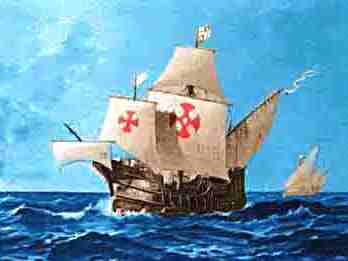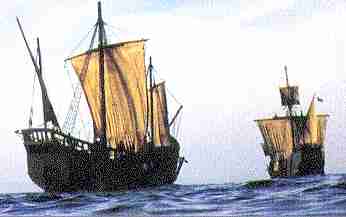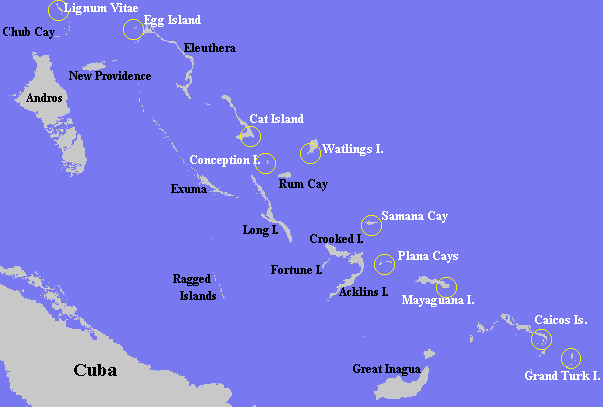|
THE SANTA MARIA
|
||
|
HOME | BIOLOGY | FILMS | GEOGRAPHY | HISTORY | INDEX | INVESTORS | MUSIC | SOLAR BOATS | SPORT |
||
|
Christopher Columbus had three ships on his first voyage: the Niña, the Pinta, and the Santa Maria. The flagship Santa Maria had the nickname La Gallega. She was broad and slow, designed for hauling cargo. Some sources say that the Santa Maria was about 100 tons, meaning that it could carry 100 toneladas, which were large casks of wine. There has been much speculation about just how large such a ship would be; the best current thinking, by Carla Rahn Philips, puts the length of Santa Maria at 18 meters, keel length at 12 meters, beam 6 meters, and a depth of 3 meters from keel to deck.
The Santa Maria had three masts (fore, main, and mizzen), each of which carried one large sail. The foresail and mainsail were square; the sail on the mizzen, or rear, mast was a triangular sail known as a lateen. In addition, the ship carried a small square sail on the bowsprit, and small topsail on the mainmast above the mainsail.
The Santa Maria
The Pinta was captained by Martín Alonso Pinzón, a leading mariner from the town of Moguer in Andalucia. Pinta was a caravel, a smaller, lighter, and faster ship than the tubby Santa Maria. We don't know much about Pinta, but it probably was about 70 tons. Philips puts the length of Pinta at 17 meters, keel length 13 meters, beam 5 meters, and depth 2 meters. She probably had three masts, and most likely carried sails like those of Santa Maria, except for the topsail, and perhaps the spritsail.
The Niña, smallest of the fleet, was captained by Vicente Añes Pinzón, brother of Martín. The Niña was another caravel of probably 50 or 60 tons, and started from Spain with lateen sails on all masts; but she was refitted in the Canary Islands with square sails on the fore and main masts. Unlike most ships of the period, Niña may have carried four masts, including a small counter-mizzen at the stern with another lateen sail. This would have made Niña the best of the three ships at sailing upwind. Philips puts her length at 15 meters, keel length 12 meters, beam 5 meters, and depth 2 meters.
PERFORMANCE
Over several days, ships of Columbus's day would average a little less than 4 knots. Top speed for the vessels was about 8 knots. These speeds were typical for vessels of the period and indeed, typical for the Age of Sail, until the advent of steam and clipper ships. Thus, on average 90 or 100 miles in a day would be typical.
Of the three ships on the first voyage, the Santa Maria was the slowest, and the Pinta was the fastest. The differences were small, however, perhaps about 0.1 knot between them. For a summary of the actual distances the fleet made every day of the voyage (in leagues), check out the First Voyage Log.
To see pictures, visit: Columbus Foundation page for the Niña replica. There are also replica ships that sail out of Corpus Christi, Texas; the local paper has articles on them.
Santa Maria and Pinta
Some five hundred years after the landing, it is still unclear just where Columbus first saw the new world. It's a subject of much debate. So far no theory put forward is conclusive but some of the best known theories are given in the links below, if you're interested:-
Map of the Bahamas, showing the suggested landfalls of Columbus
Columbus visited five islands in the Bahamas before reaching Cuba. He named these (in order) San Salvador, Santa Maria de la Concepcion, Fernandina, Isabela, and Las Islas de Arena. The last of these has been identified (almost universally) with the modern Ragged Islands in the Bahamas. The first four are in dispute. To avoid confusion with modern placenames, the first four are referred to in Roman numerals as Island I through Island IV. The native names for these islands were Guanahani for Island I and Samoete (or Saomete or Samoet) for Island IV. The native names for Island II and Island III were not recorded.
The Clues
to the Landfall
|
||
|
This
website
is Copyright © 1999 & 2007 NJK. The bird The name '1824' is a trade mark of Solar Cola Ltd. All rights reserved. Max Energy Limited is an educational charity. |
||
|
AUTOMOTIVE | BLUEBIRD | ELECTRIC CARS | ELECTRIC CYCLES | SOLAR CARS |


